Although I enjoy covering all types of hardware, high-end hardware (and those for overclocking) has a special place in my heart. No matter what brand, you’re getting the best and fastest that the chipset platform offers. Additionally, high-end boards are often some of the coolest-looking that money can buy. MSI’s X870E Godlike, which we have in the lab, exemplifies those traits and is a fine example of what a flagship motherboard should be, albeit for just under $1,100.
Hardware-wise, the Godlike blesses lucky owners with a premium audio codec and DAC/HPA, fast networking including Wi-Fi 7, 10GbE, and 5GbE ports, five native (seven total) M.2 sockets, robust power delivery with 27 total phases, a mind-blowing seven USB Type-C ports on the rear IO, an informative (and customizable) LED screen, and more. On top of that, it looks great with three tastefully implemented RGB zones, and it has the EZ Link design and EZ Bridge features for easier building and upgrades, which are just some of what we’ll cover here.
The Godlike's performance was among the best across most of the test suite. It was not only a competent gamer; as most would expect, it held up well across the remainder of the benchmarks, sometimes leading the pack. All this was done with the default settings and PBO disabled. Granted, the differences are generally insignificant, but the takeaway is that the board performs well regardless of the task.
Below, we’ll examine the board's details and determine whether it deserves a spot on our Best Motherboards list. But before we share the test results and discuss details, here are the specifications from MSI.
Specifications of the MSI MEG X870E Godlike
Swipe to scroll horizontally
| Socket | AM5 (LGA 1718) |
| Chipset | X870E |
| Form Factor | E-ATX |
| Voltage Regulator | 27 Phase (24x 110A SPSMOSFETs for Vcore) |
| Video Ports | (2) USB 4 (Type-C Displayport) |
| USB Ports | (2) USB 4.0 (40 Gbps) Type-C |
| Row 6 - Cell 0 | (5) USB 3.2 Gen 2 (10 Gbps) Type-C |
| Row 7 - Cell 0 | (8) USB 3.2 Gen 2 (10 Gbps) |
| Network Jacks | (1) 2.5 GbE |
| Row 9 - Cell 0 | (1) 5 GbE |
| Audio Jacks | (2) Analog + SPDIF |
| Legacy Ports/Jacks | ✗ |
| Other Ports/Jack | ✗ |
| PCIe x16 | (2) v5.0 (x16/x0, x8/x8) |
| PCIe x8 | ✗ |
| PCIe x4 | (1) v4.0 (x4) |
| PCIe x1 | ✗ |
| CrossFire/SLI | ?? |
| DIMM Slots | (4) DDR5-9000(OC), 256GB Capacity• 1DPC 1R Max speed up to 8400+ MT/s• 1DPC 2R Max speed up to 6400+ MT/s• 2DPC 1R Max speed up to 6400+ MT/s • 2DPC 2R Max speed up to 4800+ MT/s |
| M.2 Sockets | (2) PCIe 5.0 x4 (128 Gbps) / PCIe (up to 80mm) |
| Row 20 - Cell 0 | (1) PCIe 4.0 x4 (64 Gbps) / PCIe (up to 110mm) |
| Row 21 - Cell 0 | (2) PCIe 4.0 x4 (64 Gbps) / PCIe (up to 80mm) |
| Row 22 - Cell 0 | Via M.2 XPander-Z(2) PCIe 5.0 x4 (128 Gbps) / PCIe (up to 80mm) |
| Row 23 - Cell 0 | Supports RAID 0/1/10 |
| SATA Ports | (4) SATA3 6 Gbps (Supports RAID 0/1/10) |
| USB Headers | (1) USB v3.2 Gen 2x2 (20 Gbps) Type-C |
| Row 26 - Cell 0 | (1) USB v3.2 Gen 2 (10 Gbps) Type-C |
| Row 27 - Cell 0 | (2) USB v3.2 Gen 2 (5 Gbps) |
| Row 28 - Cell 0 | (2) USB v2.0 (480 Mbps) |
| Fan/Pump Headers | (3) 4-Pin (Accepts PWM and DC) |
| Row 30 - Cell 0 | EZ Control Hub(7) 4-pin (PWM and DC) |
| RGB Headers | (1) aRGB (3-pin) |
| Row 32 - Cell 0 | EZ Control Hub(2) aRGB (3-pin) |
| Row 33 - Cell 0 | (1) RGB (4-pin) |
| Diagnostics Panel | (1) Post Status Checker (4 LEDs) |
| Row 35 - Cell 0 | (1) 2-character Debug LED |
| Internal Button/Switch | LED Display |
| SATA Controllers | ✗ |
| Ethernet Controller(s) | (1) Marvell AQC113CS (10 GbE) |
| Row 39 - Cell 0 | (1) Realtek 8126 (5 GbE) |
| Wi-Fi / Bluetooth | Qualcomm Fast Connect 7800 Wi-Fi 7 - 320 MHz, 6 GHz, 5.8 GHz, BT 5.4 |
| USB Controllers | Asmedia ASM4242, ASM1074 |
| Row 42 - Cell 0 | Realtek RTS5420 |
| HD Audio Codec | Realtek ALC4082 + ESS9219Q Combo DAC/HPS |
| DDL/DTS | ✗ / ✗ |
| Warranty | 3 Years |
Inside the Box of the MSI X870E Godlike
Inside the premium box are a slew of accessories. In addition to the basics, MSI includes the M.2 XPander-Z Slider Gen M.2 expansion card with the EZ Slide design and an EZ Control hub for the fan and RGB headers. There are also several extension cables, thermistors, stickers, and more. The long list is below.
- Installation guide, stickers, EU Reg. notice
- EZ Clips II remove
- EZ Control hub screws
- M.2 XPander Thermal pads
- (2) Thermistor cables
- (4) SATA cables
- EZ Front Panel cable
- M.2 XPander card fan control cable
- EZ Control Hub SATA power cable
- 1 to 3 EZ Conn-Cable (V2)
- ARGB extension cable
- 1 to 2 RGB extension cable
- 1 to 3 ARGB Gen 2 extension cable
- USB drive (drivers)
- EZ Wi-Fi antenna
- EZ Control Hub
- M.2 Xpander-Z Slider Gen 5
Design of the X870E Godlike

The Godlike looks the part of a $1,000 motherboard. It’s covered in shrouds, heatsinks, LED screens, and RGB lighting areas that grace the front of the board, while a backplate covers the rear. The primary M.2 heatsink has a static RGB display while the chipset glows with the Godlike model name. The EZ Bridge sports the Dynamic Dashboard III TFT LCD panel that displays system status, temperatures, voltages, BIOS Flash status, and error messages. You can even customize it using your own image file (.gif, .bmp, .png, .jpg). The M.2 plate heatsinks sport a ribbed pattern that helps keep the four M.2 sockets it’s responsible for cool.
The X870E Godlike’s modern appearance is significantly improved over the X670E's, and the EZ Bridge with LED display elevates the flagship's aesthetic to a new level.
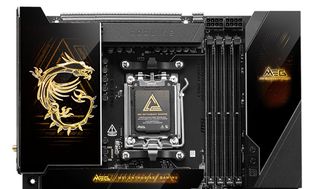
In the upper-left corner, we get a better look at the first RGB feature, with the MSI dragon and a triangle background. Typically, we’d also see the EPS power connections here, but they’re on the other side of the wavy fin, direct touch heatpipe-connected VRM heatsinks, sticking out between the shroud and the Dynamic Dashboard III.
Below the two 8-pin EPS connectors are four DRAM slots with the locking mechanism at the top (where there’s room!). MSI lists support up to DDR-9000(OC), which is plenty fast for the platform. We could run our DDR5-7200 kit, but our Klevv DDR5-8000 kit didn’t want to place nice. The sticks would boot but not complete a stress test. I didn’t see our kit on the QVL list, so we weren’t disappointed. Perhaps with some additional tweaking it could get there. As always, stick to the QVL list for your best opportunity at plug-and-play speed.
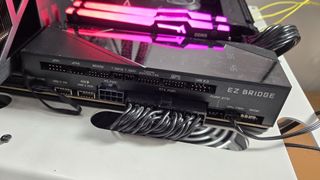
To the right of the DRAM slots is the EZ Bridge. This unique item contains the Dynamic Dashboard III (3.99-inch TFT full-color LCD, 800x480) and several connections (think front panel, USB, some fans, and more) that magnetically attaches to the motherboard. The design cleans up the board's appearance, hiding all those unsightly ports and headers. The Dynamic Dashboard displays system status, temperatures, voltages, BIOS Flash status, error messages, and accepts custom images.
Front top to bottom, you have a 4-pin ARGB, CPU and PUMP fan, 24-pin ATC power, supplemental 8-pin PCIe power (required for 60W charging via USB-C), Front panel USB 3.2 Gen 2x2 (20 Gbps) and Gen 2 (10 Gbps) Type-C ports, and another 4-pin fan header. The Godlike includes the EZ Control Hub that attaches to the JBRG_HUB1 port on the EZ Bridge. The hub offers seven more fan headers (for a total of 10), two ARGB and one 3-pin RGB header, and a connection for water flow. Power for the hub comes from a SATA power connector, while control over most of the devices is handled through the MSI Center and its applications, or some (like fans) also allow control through the BIOS.

Power delivery on the Godlike consists of 27 phases, 24 dedicated to Vcore. Power comes from the 8-pin EPS connector(s) onto a Renesas RAA229628 controller. From there, it moves to the 110A SPS MOSFETs. The 2,640A available is plenty for even the flagship Ryzen 9 7950X or 9950X. The VRMs are one of the most robust on the platform and will not hold you back, even if you decide to overclock using sub-ambient cooling methods.
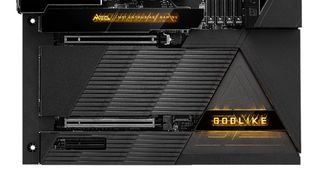
On the bottom left side, hidden under the heatsink, is a flagship-class audio solution based on the 7.1-channel Realtek ALC4082 codec/chip and supported by an ESS 9219Q Combo DAC/HPA, its own audio capacitors and the audio separation line to minimize EMI. You won’t find much better audio hardware on a modern motherboard.
Three PCIe slots and five M.2 sockets are in the middle of the board. The top PCIe slot connects through the CPU, running up to PCIe 5.0 x16 and uses a convenient button located on the EZ Bridge to lock and unlock the video card in its slot. The second slot also connects through the processor and runs up to PCIe 5.0 x8 speeds. When both slots are populated, they both run at x8 speeds. The bottom PCIe x4 slot connects through the chipset and runs at PCIe 4.0 x4. Note that the bottom slot will run at x2 speeds when the M.2_4 socket is populated. You can switch it to x4, but this disables the M2_4 slot.
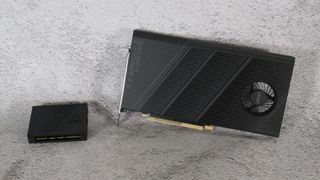
Onboard, two M.2 sockets (M.2_1/2) are PCIe 5.0 x4-capable and handle up to 80mm modules. M.2_3/5 connects through the chipset and runs PCIe 4.0 x,4 while the M.2_4 is limited to PCIe 4.0 x2 (fine for PCIe 3.0 x4 modules). If you need additional PCIe 5.0 M.2 storage, MSI includes the M.2 Xpander-Z Slider Gen 5 add-in card with two PCIe 5.0 x4 slots with an EZ Slide design for quick installation/removal. You don’t have to remove the card from your PC to access them. The Godlike can hold a wild seven M.2 drives - the most I recall seeing on any consumer motherboard.
Past the second RGB feature above the chipset to the right edge is the standard fare of connectors for the space, including two 19-pin USB 3.2 Gen 1 (5 Gbps) headers, supplemental PCIe power, two SATA ports, a USB 2.0 header, and front-panel audio.
There isn't much across the bottom of the board, as many headers are in the EZ Bridge. Under a magnetic strip, you’ll find the other two SATA Ports, three switches (Dashboard, LED, BIOS Select), LN2, battery (CMOS), and OC jumpers.

The rear IO on the X870E Godlike has a lot going on, as you’d expect. The black background with white writing allows for easy reading and properly labels each port so you know exactly what it is. Starting with USB ports, there’s a total of fifteen, with seven of those being USB Type-C! You get two 40 Gbps (with DisplayPort capability) and five 10 Gbps Type-C, with eight more 10 Gbps Type-A ports. In the middle are three buttons - one to Flash the BIOS, a second to clear the CMOS, and the third is a Smart Button (Reset, Mystic Light on/off, Safe Boot or Turbo Fan). Above those are the two Ethernet ports (10 Gbps and 5 Gbps), standard Wi-Fi 7 antenna connections, and the two-plug (mic-in and line-out) plus SPDIF audio stack.
MORE: Best Motherboards
MORE: How To Choose A Motherboard
MORE: All Motherboard Content

 11 hours ago
6
11 hours ago
6
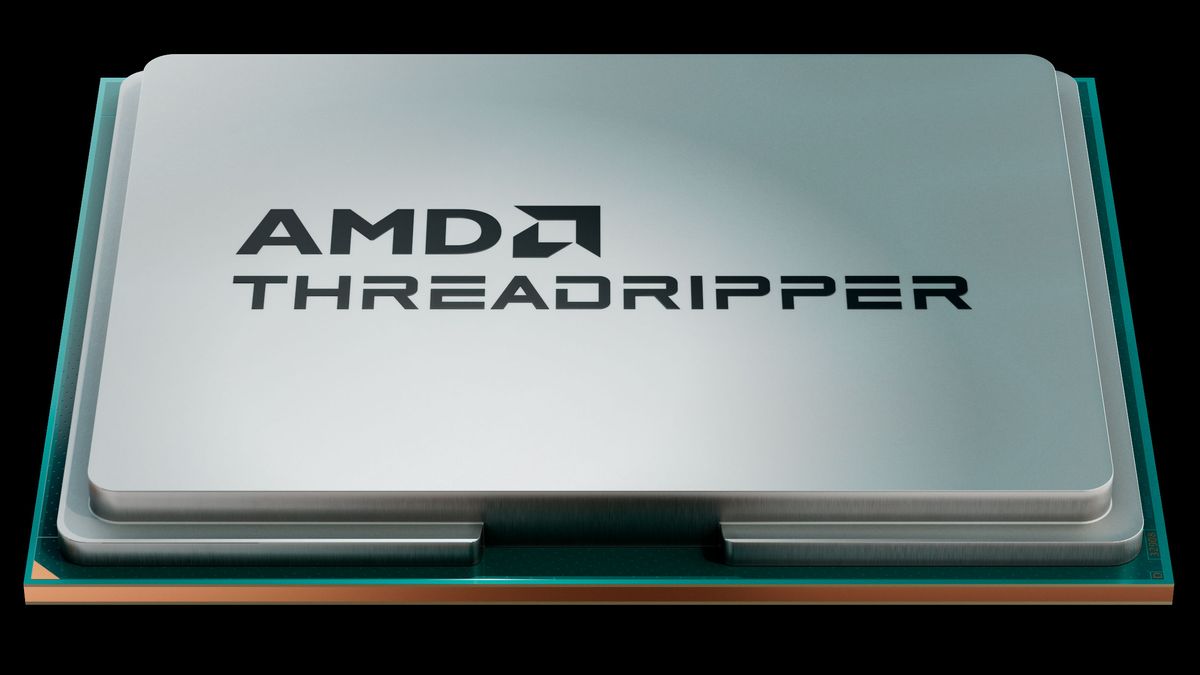

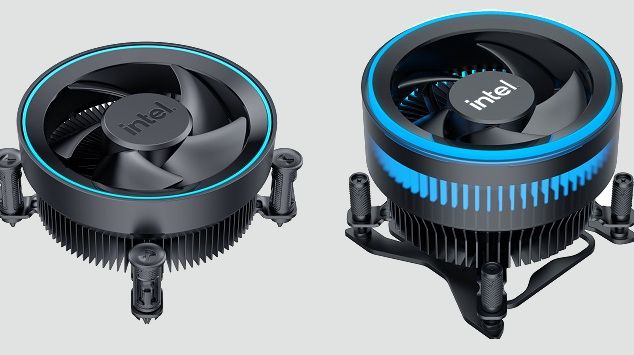


/cdn.vox-cdn.com/uploads/chorus_asset/file/25825874/fortnite_festival_multiplayer.png)

/cdn.vox-cdn.com/uploads/chorus_asset/file/25821777/DSCF4473.jpg)
 English (US) ·
English (US) ·